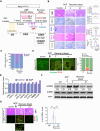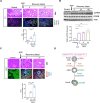This is a preprint.
CREB drives acinar cells to ductal reprogramming and promotes pancreatic cancer progression in preclinical models of alcoholic pancreatitis
- PMID: 38903082
- PMCID: PMC11188065
- DOI: 10.1101/2024.01.05.574376
CREB drives acinar cells to ductal reprogramming and promotes pancreatic cancer progression in preclinical models of alcoholic pancreatitis
Update in
-
CREB Drives Acinar to Ductal Cells Reprogramming and Promotes Pancreatic Cancer Progression in Preclinical Models of Alcoholic Pancreatitis.Cell Mol Gastroenterol Hepatol. 2025 Aug 12;19(12):101606. doi: 10.1016/j.jcmgh.2025.101606. Online ahead of print. Cell Mol Gastroenterol Hepatol. 2025. PMID: 40812683 Free PMC article.
Abstract
Background & aims: Chronic alcoholism often leads to pancreatitis, which exacerbates pancreatic damage through acinar cell injury, fibrotic inflammation and activates AKT/mTOR/cyclic adenosine monophosphate response element binding protein 1 (CREB) signaling axis. However, the molecular interplay between oncogenic Kras G12D/+(Kras*) and CREB in promoting pancreatic cancer progression under chronic inflammation remains poorly understood.
Methods: Experimental alcoholic chronic pancreatitis (ACP) induction was established in multiple mouse models, with euthanasia during the recovery stage to evaluate tumor latency. CREB was selectively deleted (Crebfl/fl ) in Ptf1aCreERTM/+;LSL-KrasG12D/+ (KC) genetic mouse models (KCC-/- ). Pancreata from Ptf1a CreERTM/+, KC, and KCC-/- mice were analyzed using histological profiling, western blotting, phosphokinase array, and quantitative PCR. Single-cell RNA sequencing was performed in ACP-induced KC mice. Lineage tracing analysis in YFP reporter mice and acinar cell explant cultures analysis were also conducted.
Results: ACP induction in KC mice significantly impaired pancreas' repair mechanism. Acinar cell-derived ductal lesions demonstrated sustained CREB hyperactivation in acinar-to-ductal metaplasia (ADM)/pancreatic intraepithelial neoplasia (PanIN) lesions associated with pancreatitis and pancreatic cancer. Persistent CREB activity reprogrammed acinar cells, and increased profibrotic inflammation. Notably, acinar specific Creb deletion in ACP induced models suppressed high grade PanIN development, restrained tumor progression, and improved acinar cell function.
Conclusions: Our findings demonstrate that CREB and Kras* promote irreversible ADM, accelerating pancreatic cancer progression with ACP. Targeting CREB may present a promising strategy to mitigate inflammation-driven pancreatic tumorigenesis.
Keywords: acinar-to-ductal metaplasia; alcoholic chronic pancreatitis; cAMP response element binding protein 1; pancreatic ductal adenocarcinoma; pancreaticcancer; pancreaticintraepithelial neoplasia.
Conflict of interest statement
Disclosures: The authors declare no potential conflicts of interest.
Figures







References
-
- Nieto LM, Salazar M, Kinnucan J, et al. Incidence, Burden, and Predictors of Readmission for Acute Alcoholic Pancreatitis: A National Analysis over 11 Months. Dig Dis Sci 2023;68:423–433. - PubMed
-
- Singer MV. Effect of ethanol and alcoholic beverages on the gastrointestinal tract in humans. Rom J Gastroenterol 2002;11:197–204. - PubMed
-
- Dufour MC, Adamson MD. The epidemiology of alcohol-induced pancreatitis. Pancreas 2003;27:286–90. - PubMed
Publication types
Grants and funding
LinkOut - more resources
Full Text Sources
Research Materials
Miscellaneous
